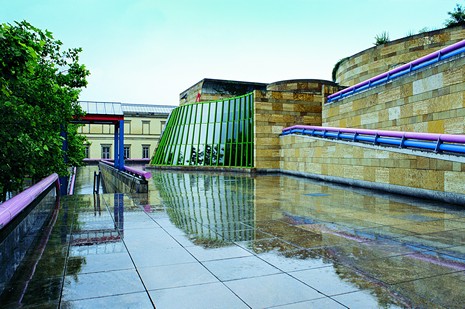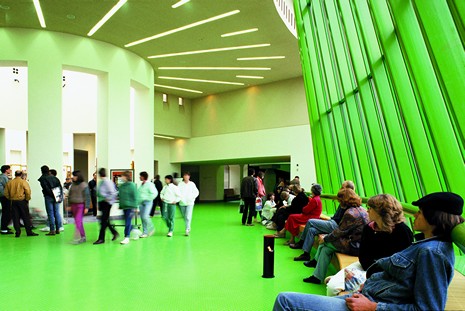Description
“I want to give visitors the impression that this isn’t just a museum, but a place for entertainment. My building should exude cheerfulness and bold design,” said James Stirling as he outlined his goals for the Neue Staatsgalerie in Stuttgart, whose architecture has enjoyed unusual popularity since the controversial competition decision.
In the development area on a hillside, resolutely cut off from the city centre by a main road and therefore not particularly attractive, the architect placed his new building next to and strictly parallel with the Alte Staatsgalerie, neoclassicist in style, repeating its courtyard in the U-shaped layout of the new exhibition wings that symmetrically enfold an enormous rotunda at the centre. Stirling contrasts this layout of rotunda and right-angled enfilade wings, which appears monumental in the ground plan but hardly so in built reality, with an almost extravagant abundance of very different motifs such as asymmetrically placed ramps with oversize railings in shocking pink and blue, Egyptian corbel cornices, and the concertina-like undulating glass wall of the entrance hall. This way, the regular forms of the basic structure are transformed into a dynamic architectural landscape that is inviting to walk through, in intentional contrast to the strict ground plan based on classical models, now hardly recognisable. The ensemble, separated from the road by two rows of trees, appears to be a large-scale sculpture that can be walked through, its perspectives continually changing.
The main level, which is also the entrance level, is placed on a pedestal that hides the underground garage, and which can be accessed both by a ramp and a stairway opposite. Both of these start out underneath a steel case that simultaneously evokes both the primeval hut frequently invoked in architectural theory and that elementary dignity-evoking motif, the canopy. Here it shields an Egypticized wall-opening that leads directly into the underground garage, of all things. The real entrance to the museum is located on the main level, but shifted to the side and surprisingly, situated underneath a garishly painted cantilevered steel grille that forms a peculiar contrast to the apparent solidity of the stone walls. Upon closer examination, however, these latter turn out to be a thin cladding of alternating layers of sandstone and travertine slabs on the cast concrete building – and this too is carefully staged, in some places virtually put on display.
Like this, the tone for the basic attitude of this architecture is set almost as a leitmotif: historicising and contemporary motifs and the accompanying associations are not only set in relation to each other so as to fuse into a new synthesis, but also the associations that have accrued to them are at the same time relativized in such a way that the architecture appears to comment – occasionally ironically – on them too. The aggregation of forms and materials – almost always implemented skilfully and with a sure hand – that thus comes into being is simultaneously the synthesis and the reflection of contradictory styles and contents, in this way forming a new canon that unites the “monumental with the informal,” as the architect puts it.
This attitude becomes particularly evident in the form and function of the enormous central rotunda, a motif already found in earlier museum designs by Stirling that were not executed, a motif that, like the whole ground plan of the Stuttgart Staatsgalerie, quotes Schinkel’s Altes Museum in Berlin as one of the prototypes of this commission and in so doing, follows an architectural tradition that goes back to the Pantheon in Rome. In contrast to Schinkel’s model, Stirling’s rotunda is not domed like a “pantheon of the arts,” but designed as a hollow cylinder open at the top, the walls of which are overgrown with vegetation like a ruin, in ironic reversal of the neoclassicist pathetic formula that reaches its logical conclusion in the footpath (required by the client as the link between the streets on either side of the museum) that spirals around the high wall of the rotunda and thus transforms it into external space. As further evidence of the intentional multilayered quality and the ambiguity of this architecture this twisted ramp quotes Frank Lloyd Wright’s Guggenheim Museum in New York as one of the incunabula of modern museum architecture (and also reverses inside and outside with this allusion).
The rich variety of contradictions in this postmodern scenario continues through the spacious foyer, a fluid space accentuated by a small rotunda lighted from above and visible from the outside as well through the fluted glass wall. Here too, the dignity-evoking tempietto motif – contrasting garishly with the provocative pop-art-inspired bright green floor – is meaningfully interpreted: it contains the ticket window and the museum shop.
A ramp and a high-tech elevator give access to the classically proportioned, coved-ceilinged gallery rooms on the upper storey, arranged in enfilade fully in keeping with the tradition of the nineteenth- century museum buildings and their predecessors in baroque palace architecture. The entertaining scenario of the architecture of the exterior and the access area here gives way to a cool, quiet atmosphere in which at best the green-painted grids of the roof lights and isolated pieces of moulding detached from the wall and concealing high-wattage lights still remind one of the previous scenario.
wettbewerbe aktuell 12/1977, pp. 715-724 • Deutsche Bauzeitung 8/1980, pp. 22-24 (Falk Jaeger) and 9/1984, pp. 38-41 (Gerhard Ullmann) • Der Architekt 7-8/1984, pp. 343-348 (Christoph Hackelsberger) • Architectural Design 3-4/1984, pp. 48-55 (Charles Jencks) • Bauwelt 20/1084, pp. 832-851 (Jochen Bub) • The Architectural Review 1033/1983, pp. 31-41 (Peter Cook) and 1054/1984, pp. 18-47 • Heinrich Klotz, Moderne und Postmoderne, Braunschweig/Wiesbaden, 1984, pp. 340-341 • Neue Staatsgalerie und Kammertheater Stuttgart, ed. The Ministry of Finances for Baden-Württemberg, Stuttgart, 1984 • Thorsten Rodiek, James Stirling. Die Neue Staatsgalerie Stuttgart, Stuttgart, 1984 • L’architecture d’aujourd’hui 235/1984, pp. 7-15 (Jean-Marc Ibos, Dominique Lyon) • Baumeister 8/1984, pp. 54-68 • Casabella 503/1984, pp. 38-41 (Giacomo Polin) • Domus 651/1984, pp. 2-15 • Kunstchronik 37/1984, pp. 369-377 (Wolfgang Pehnt) • das kunstwerk 3/1984, pp. 45-51 (Gunild Berg, Rolf-Gunter Dienst) • Lotus international 3/1984, pp. 23-46 (Frank Werner) • Progressive Architecture 10/1984, pp. 67-85 (Susan Doubilet) • Architectural Record 9/1985, pp. 140-149 (Martin Filler) • Arquitectura 5-6/1985, pp. 45-58 (Ignasi de Solá-Morales) • Umbau 8/1984, pp. 17-26 (Friedrich Achleitner) • James Stirling. Bauten und Projekte 1950-1983, Stuttgart, 1984, pp. 252-260 • Jahrbuch für Architektur, Frankfurt am Main, 1984, pp. 131-140 and 1985/86, pp. 131-140 (Heinrich Klotz) • Museumskunde 50/1985, pp. 112-125 (Norbert Knopp) • Hannelore Schubert, Moderner Museumsbau, Stuttgart, 1986, pp. 155-157 • Heinrich Klotz/Waltraud Krase, New Museums, London, 1986, pp. 20-22 and pp. 104-120 • Techniques & Architecture 368/1986, pp. 114-118 (142-146) • Francesco Dal Co/Tom Muirhead, I Musei di James Stirling, Michael Wilford and Associates, Milan, 1990, pp. 104-127 • Jost Schilgen, Neue Häuser für die Kunst, Dortmund, 1990, pp. 46-67 • Douglas Davis, The Museum Transformed, New York, 1990, pp. 114-121 • Alexander Tzonis/Liane Lefaivre, Architecture in Europe since 1968, London, 1992, pp. 126-131 • Laurence Allégret, Musées, vol. 2, Paris, 1992, pp. 66-71 • Bauwelt 38/1993, pp. 2049-2051 (Frank Werner) • James Stirling, Michael Wilford and Associates. Buildings and Projects 1975-1992, Stuttgart, 1994, pp. 54-63 • James Steele (ed.), Museum Builders, Berlin, 1994, pp. 234-239 • Josep M. Montaner/Jordi Oliveras, Museums for a New Century, Barcelona, 1995, pp. 106-111 • Robert Maxwell, James Stirling. Michael Wilford, Basel, 1998, pp. 72-77 • Victoria Newhouse, Towards a New Museum, New York, 1998, pp. 179-181 • Gert Kähler, Ein Jahrhundert Bauten in Deutschland, Stuttgart/Munich, 2000, pp. 190-191
Drawings
Site plan
Entrance level
Gallery level
Cross section through the rotunda
Longitudinal section of the rotunda
Cross section of a large gallery room
Axonometric view of the rotunda
Photos

Entrance level from the south; in the foreground the ramp with the oversized hand-rails leading into the central rotunda

The sales rotunda in the entrance level
Originally published in: Paul von Naredi-Rainer, Museum Buildings: A Design Manual, Birkhäuser, 2004.